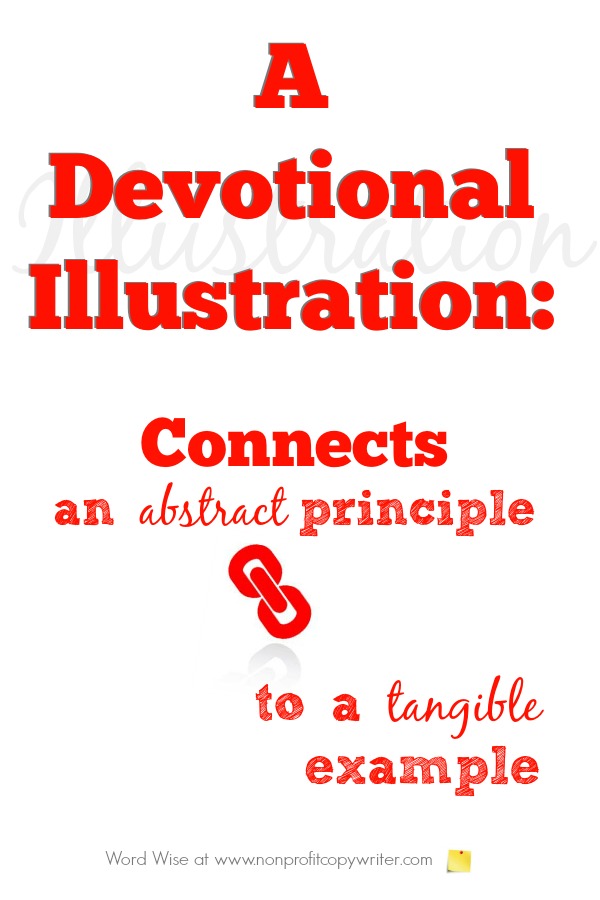Save Time: Get 5 Simple Writing Tips
you can put to use in 10 minutes
Use a Devotional Illustration to Connect the Abstract to Real-Life
Award-winning writer Kathy Widenhouse has helped hundreds of nonprofits and writers produce successful content , with 750K+ views for her writing tutorials. She is the author of 9 books. See more of Kathy’s content here.
A devotional illustration is sometimes called the body, the narrative, or even the “devotional” itself. It is one of three of the parts of the standard devotional structure:
- Scripture
- Illustration
- Takeaway
The illustration is the longest section of the three. It does the “heavy lifting” in the devotional by communicating the devo’s spiritual truth – its point – and connecting it to a real-life situation. (More about the devotional point.)
A Devotional Illustration: Abstract Becomes Concrete
A devotional’s point is abstract: love, joy, peace, patience, steadfastness, goodness, mercy, forgiveness, grace …
An illustration is a word picture. When you use words to paint a picture, your reader can “see” a tangible image in her mind, much like a verbal slide or a still photo.
A devotional illustration translates an abstract principle into a concrete reality. Like a dot-to-dot picture, the illustration connects the devotional’s spiritual truth to a tangible image in the reader’s mind so she can understand it.
An Example
Jesus Christ was a master as using illustrations to connect a spiritual truth to a concrete reality. He told the story of a woman who had ten coins, but lost one. She searched her house from top to bottom, cleaning and sweeping even by the light of a lamp, until she found the missing coin. Then she called together her friends to celebrate finding it (Luke 15:8-10).
It’s a real life situation — one we can relate to even today. Most of us have misplaced a wallet or checkbook at some point, and have experienced the heart palpitations and sweaty hands that go with that experience. You empty desk drawers … search under car seats … empty all your pockets … retrace your steps … all to find the wayward item.
Use the Illustration to Connect the Dots
Your well-chosen illustration by itself is not enough to complete your devotional. You need to spell out how your illustration connects to your point. Explain in plain language how the details in the illustration reveal the point – the spiritual truth.
Once Jesus painted the picture of the lost coin for His listeners, He then made the connection to a spiritual principle — the point: “There is joy before the angels of God over one sinner who repents.” Put plainly, heaven’s residents celebrate passionately when a person is found by God.
The concept of “Rejoicing of angels in heaven” is abstract. You may imagine lots of wing-flapping and halo-tossing, but since you haven’t experienced that kind of gathering firsthand, it is hard to grasp.
On the other hand, finding lost money is much more relatable. You can identify with the woman’s celebration because you understand the relief and joy you experience with finding your wallet. The illustration helps you feel and understand a smidgen of how God celebrates with His fellow residents of heaven when you’re lost and then found.
The word picture paints a concrete image for your reader. Your explanation connects your readers to your point.
Your devotional illustration is complete – and connects the dots for your reader – with both.
More about Devotional Writing
How to Write Devotionals: Use a 3-Part Structure ...
Save Time: Identify the Devotional Point Before You Write ...
Writing Devotionals That Stick: a step-by-step writing guide ...
More tips for writing devotionals on our Pinterest board ...
Return from a Devotional Illustration to Nonprofit Copywriter home
As an Amazon Associate I earn from qualifying purchases.
Share This Page

Named to 2022 Writer's Digest list
BEST GENRE/NICHE WRITING WEBSITE


Stop Wasting Time!
Grab your exclusive FREE guide, "5 Simple Writing Tips You Can Put to Use in 10 Minutes or Less"












